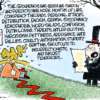I have long been skeptical of the merits of running around screaming that the sky is falling. If the sky were really falling – I assumed – everyone would notice and behave accordingly. The last two weeks have challenged that assumption, though. In a situation where the sky really does appear to be falling, millions of people are working desperately to convince themselves otherwise. Even now, when reading the daily headlines makes anyone sound like a conspiracy nut, many are beset by the impulse to believe that what we are seeing cannot possibly be as bad as it appears to be.
It’s a very human impulse, a product of our amped-up simian brains. We have a cognitive bias towards normalcy: we assume that what happens next will look very much like what has happened before. As a consequence, we chronically underestimate both the likelihood and impact of disasters. As it turns out, the sky can be falling and many will simply look up and say “no it’s not.”
But it is, and our best chances of holding up the firmament before it crushes us flat are all improved when more of our fellow citizens understand the predicament. And so, I have had to update my assumption and reluctantly roll-back my skepticism. I have reassessed the merits of running around screaming that the sky is falling, and think there may be some benefit to it after all.

If the task is to circumvent the normalcy bias that is preventing our friends, our neighbors, and many of our elected leaders from appreciating the scale of the threat, where do we start? The field of cognitive linguistics might provide the answer, with its demonstrations that what we can conceive of is limited by what we have the vocabulary for. If we do not have the language to describe what we are seeing, we are likely to see it incorrectly. If we encounter something which we have not conceived as being within the realm of actual possibility, we are unlikely to accept it at face value when we see it. We are apt to mistake it for one of the possibilities we have already accepted.
If that sounds familiar to you, it’s probably because that exact dialectic has been playing out in your brain and your nervous system for the last few weeks. You see the warning signs and your heart rate escalates. Then you see life around you proceeding as normal, or you see reporters and politicians reacting as they have to any number of other political happenings in your lifetime, and the normalcy bias kicks in. Those warning signs recede into your gut, where they are reactivated every few hours by another red flag, then smothered again by the overwhelming pretense of normalcy. Without the language to affirm what we are seeing, it can be hard to maintain a sturdy belief in our lying eyes.
We have to expand our vocabulary, and our mental framework, for living in these times. We need the language to describe what we are seeing: a democratically elected president behaving in fundamentally undemocratic ways. An assault on a democratic government by its democratically elected leader.
Fifty-four years ago, two political scientists (Melville and Melville, believe it or not) coined a term for this. Autogolpe. You will occasionally see it rendered in English as “self-coup” or “autocoup,” but neither translation into our clunky Latin-Germanic language quite captures the essence with which Spanish noun construction imbues the original. As a result, autogolpe is often employed in English as a loanword.
As you might have guessed from the imperfect translations, an autogolpe is a kind of coup d’etat, or government overthrow. Specifically, it is a coup d’etat “performed by the current, legitimate government or a duly elected head of state to retain or extend control over government, through an additional term, an extension of term, an expansion of executive power, the dismantling of other government branches, or the declaration that an election won by an opponent is illegitimate.”

It has happened before. The example most closely linked to the term is probably the Peruvian autogolpe of 1992, when democratically elected president Alberto Fujimori dismissed the legislative and judicial branches of the Peruvian government and claimed their powers for himself. The reality of what followed is unsettling: Fujimori’s autogolpe was remarkably popular, and he remained in power for another eight years. (17 years after his coup, Fujimori was convicted of human rights violations stemming from his time in office and sentenced to 25 years in prison).
There are more recent examples as well: in 2020, through what appears to have been a massively, almost comically rigged ballot, Russian President Vladimir Putin passed a constitutional referendum which allows him to remain in the presidency longer than the previous Russian constitution would have allowed.
Also in 2020, Salvadoran strongman Nayib Bukele marched soldiers into El Salvador’s parliament building to force the legislators to pass legislation he supported. The following year, after his party won a legislative majority, Bukele had them remove from the nation’s Supreme Court five justices who had opposed him, and fire the attorney general who was investigating him for corruption.
Perhaps the most famous autogolpe in history happened in 1933, when the German Reichstag, spooked by a recent fire, passed The Enabling Act to grant the duly elected Chancellor the extraordinary authority to make and enforce laws. The rest is history.
If there is still any doubt that the Trump administration’s early actions constitute – at the very least, the early stages of – an autogolpe, look back at the definition and check the boxes. Donald Trump is “a duly elected head of state” taking actions to “extend control over government” through “an expansion of executive power” and “the dismantling of other government branches.”
The assertion of presidential power to unilaterally impound congressionally approved funds was not a misstep, it was a shot across the bow. Back in November, Musk wrote an op-ed in the Wall Street Journal telegraphing the move ahead of time. In the same piece, he said that they intended to pursue the question to the Supreme Court, if necessary, and that they expect the court to rule in their favor. If he is right about that, if SCOTUS does in fact side with Trump’s claim that he has that unilateral right – or, indeed, if the Republican-controlled Congress passes legislation to that effect – there will be no technicalities standing between our reality and the reality described by the term autogolpe. At that point, it will be complete.
But I would not advise getting too hung up on the technicalities: for all intents and purposes, we are already there. When Donald Trump claimed the right to freeze all federal spending and his cronies in the congressional majority defended the claim, we had all the information we needed. The rescission of that decision was not a defeat for Trump, it was a tactical retreat. The assertion that Trump can overrule the legislative branch will be back. We can reasonably expect it to be the theme of the next few years.
As it unfolds, as Trump’s autocoup proceeds towards SCOTUS, or through the halls of his crony Congress, the least we can do is remember that we have the language for it, that we have the mental framework for it. The least we can do is remember that we do not need to restart the cycle of shock-succumbing-to-normalcy-bias every time we are reminded of it.
It’s an autogolpe, and it’s happening right in front of our eyes.




